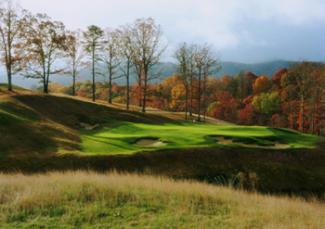Featured Golf News
Ballyhack an Exacting Test
Much has been written about Ballyhack Golf Club, Lester George's wonderful and exacting test in the rolling hills just outside Roanoke, Va. But reading and hearing about the course is a lot different than actually standing on the first tee and for the next four hours maintaining the concentration necessary to fare well on this superior combination of club choice, challenge and charm.

Ballyhack Golf Club
Built on 190 acres of a 370-acre former farm and opened in July 2009, George's 18-hole jewel is a highland-style track that incorporates dramatic topography. Holes on either side of the road that brings golfers to the site from the city are routed mainly through valleys featuring 50- to 70-foot elevation changes. Other features include fairways as wide as 150 yards and gouged-out, rough-looking bunkers.
Ballyhack sits in the shadow of the Blue Ridge Mountains and offers panoramic views of the range throughout the round. "This is huge, huge terrain - it's amazing," said George, who also fashioned and, until Ballyhack, was likely best known for his work at Kinloch Golf Club outside Richmond, which is rated among the top-10 private courses in the country. It was constructed by Bill Kubly's Landscapes Unlimited, one of the most respected course builders in the golf industry.
"Ballyhack is one of the most-balanced and rhythmic designs of my entire career," George continued. "The property has naturally bold and domineering features that are perfect for a true links-style golf course. And the wind howls through there. The surrounding mountain passes are called Windy Gap for a reason."
The property is only a 15-minute drive from downtown Roanoke, but is feels isolated on the farmland. Because it is federally designated as "view-preserved," no development will ever abut Ballyhack. The 7,294-yard, par-72 layout blends modern design principles with Europe's Old World links courses. "This golf course has been in my head and heart for years," George claimed.
Be advised, Ballyhack will get its pound of flesh from even the best golfers; it justifiably carries a 76.6 rating and a 155 slope from the tips (named the "Big Lick" tees).

The 7th Hole at Ballyhack
George Makes You Choose
So how does the course play? It's definitely tough, with plenty of forced carries and huge sloping putting surfaces and green surrounds. A;though Ballyhack occupies both sides of a two-lane roadway, the two nines are a seamless; just because you move from the front nine to back, the challenge never stops.
"My most obvious design challenge was how I would route the course using the farm that bordered opposite sides of a major secondary road," George said. "We solved it by tunneling under the road. Upon leaving the clubhouse, players will cross under the road toward the first tee for the front nine, which is routed around and between several major ridges that create the high dune look. Between the ridges, there is a beautiful moor that we used as a prominent feature for the first, sixth, seventh and eighth holes."
The fun starts at the 399-yard par-4 opener, which involves a carry of 178 yards from the tips (162 from the second tee) to an uphill and wide landing area. Once past this scary-looking opening shot across a deep ravine, the fairway runs uphill to a large green with a false front. Take an extra club here as any ball short could roll all the way back down to where it originated.
The second is a 538-yard par-4 that plays from a high dune to a natural ridge. In places, the fairway is over 100 yards wide. The second green is 10,000 square feet in size and sits vicariously atop the ridge, requiring finesse and power to reach in two.

Ballyhack's 8th Has a Hidden Fairway on the Right
The 251-yard third makes a bold statement. This par-3 plays into a small valley and is bordered by Saul Run on the left side. The player must accurately judge the distance to get close to the hole because the big green is sectioned by undulations.
At 467 yards from the tips, Ballyhack's fourth is the longest two-shotter on the front. If offers multiple routes by virtue of a four-terraced fairway protected by Saul Run on the right and trees on the left. If you play the first four holes at Ballyhack in even-par or better, the course manager should give you a new pair of shoes as it's a heck of a slog.
The 354-yard par-4 sixth defiantly tempts players to drive over the moor to the green, while the 191-yard seventh is a mid-length par-3 that plays across Horseshoe Moor to a large green on a ledge above the lowlands.
The outward nine concludes with a 546-yard par-5 that, on most days, plays into the wind and requires one to aim at Ballyhack's iconic silos across Pitzer Road off the tee and to avoid a "hell bunker" in the middle of the landing area.
Probably one of the most memorable offerings at Ballyhack, the 10th is a sweeping 595-yard par-5 that moves left to right and offers incredible views of Windy Gap Mountain and the "gap" beyond.
No. 12 is a massive par-4 that usually plays into the wind and must be attacked from the right part of the landing area. Ballyhack's 13th and 15th share a double green. "At approximately 25,000 square feet, and separated by a seven-foot-deep swale, this unique feature for these two holes fits into the landscape so well I couldn't pass up the opportunity to build it," George writes in the hole descriptions.
On the 575-yard, par-5 15th, with the prevailing wind usually facing, players can elect to hit an abbreviated drive to the "short porch" of the fairway in front of a daunting chasm. This will lead to a longer, but more direct, second shot over the hazard to a generous landing area. A bolder drive down the fairway will leave a shorter, yet more complicated look at the landing area in front of the green.
The last three holes at Ballyhack illustrate George's talent and inspiring feel for the land. At 491 yards, the 16th is situated on one of the most interesting landforms on the property: a natural "cape" that provides another opportunity for the player to bite off as much as he dares off the tee. But any shot too far right may go into Ballybrook that borders the hole. Once safely in the fairway, the second shot must avoid two hazards - one that cuts across the landing area and Ballybrook to the right.
The 152-yard 17th is the shortest hole on the course. The green is located across one of the deepest ravines on the property and is surrounded by trouble; any shot hit short or right is lost. The green is trisected by a hogback.
The final hole is a 455-yard par-4 that plays through the middle of a ravine into a natural punchbowl green that is approximately 21,000 square feet in size. It's easily possible to have putts over 100 feet if not on the correct level.
This is a pure golf experience for lovers of the game but is not for the squeamish. Ballyhack's routing balances distance, shot-making skills and difficulty that players will remember long after the last putt.
Why is it called Ballyhack? The property was named 100 years ago by the man who bought the property. The name had nothing to do with golf, despite how much it sounds like an old Scottish course.
Ballyhack was recognized by Golf Magazine as the No. 3 Best New Private Course of 2009 and as one of Links Magazine's Best New Private Courses.
The owners' vision is for the members to feel as though the club is their own personal retreat, to play the course without scheduling a tee time and to stay in one of the fully-appointed golf cottages, watching the mist rise off the 18th green in the morning or the sun set over the 12th fairway in the evening. I can think of nothing else that is so appealing.
For more information, visit www.ballyhackgolfclub.com.
Steve Habel is one of Cybergolf's national correspondents, contributing news stories, features, equipment and book reviews and personality profiles from his base in Central Texas. He is also the managing editor for Texas CEO Magazine and works as a contributing editor for Horns Illustrated magazine, a publication focusing on University of Texas sports. He also writes a blog (www.shotoverthegreen.blogspot.com), which features news on golf and the Longhorns, and another (www.checkinginandplayingthrough.blogspot.com) on his many travels, which took him across the nation and to 105 different golf course in 2009. Habel is a member of the Golf Writers Association of America and the Texas Golf Writers Association.
Story Options
 |
Print this Story |
